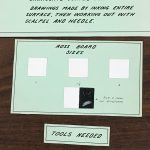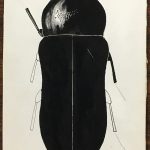For the past several weeks, Zach Griebenow (undergraduate student assistant, blogger, majoring in Entomology), and I, with some help from Abbie Zimmer (volunteer, majoring in Art) and Dr. Natalia Molotievskiy, have been reorganizing the beetle holdings of the Triplehorn collection to reflect the changes in the classification of the Coleoptera at the superfamily and family levels (per Bouchard et al., 2011). This is a laborious process that involves moving (almost) all of the 1,629 (heavy!) wooden drawers containing beetles. On any given day we may move 100-200 drawers in a couple of hours. We are now more than two-thirds of the way done and hope to finish ‘the big switcheroo’ in 2-3 weeks. This re-organization is a big step, and it will greatly facilitate the next phase of the re-curation and digitization of the beetles in the collection.
As we worked, moving drawers in and out of tall metal cabinets, I had a chance to look at the contents of the collection again, not with the critical eye of the professional whose job is to upgrade the curatorial status of it, but with the eye of the student who was seeing it for the first time. This rekindled my appreciation for Joe Knull’s work and his dedication to the collection.

Josef N. Knull
For those unfamiliar with the Triplehorn Insect Collection’s history, Josef Nissley Knull (1891-1975) was hired in 1934 as the full-time curator of insects, and that marks the initiation of a formal entomological collection at Ohio State.
Joe Knull was notoriously meticulous in his care for the collection. He was held up by most entomologists across the country as the extreme example of tidiness and organization. We still have many drawers of beetles that were arranged by him: long series of accurately determined, properly mounted, neatly positioned, and perfectly preserved specimens. There are many stories about Joe’s strict rules in the collection: no smoking, no whistling, no careless people, absolutely no breaking specimens. He allegedly kept a list of all the people who broke specimens. Unfortunately, we have no hard evidence that this list existed, but those who knew him say it would be very much like Joe to do that.
For 28 ½ years Professor Knull devoted his career to the expansion and arrangement of the collection. Each summer of all those years, and those afterward during his retirement, was spent in the field with his wife and fellow entomologist, Dr. Dorothy Johnson Knull. Both were outstanding collectors, and the results of their efforts are reflected in the volume and diversity of material they added to the collection.
Joe was interested in all insects, but he was dedicated to the study of beetles. He published more than 190 papers between 1918 and 1975, particularly on the families Buprestidae, Cerambycidae, Elateridae and Cleridae (Davidson & Bellamy, 2002). The many years of field work with emphasis on beetles, particularly in the Midwestern and Southwestern states, resulted in a truly outstanding collection of North American Coleoptera.
Professor Josef Knull retired from OSU in January of 1962, but continued collecting and contributing to the OSU collection until the early 1970’s. He died, here in Columbus, on April 24, 1975 at the age of 83. His legacy lives on in every publication generated by the use of the specimens he so carefully collected and preserved, in every visit the collection receives by scientists from the US and abroad, in every specimen image we make available online, in every database query of the 148,154 beetle specimens we have already digitized.

Beetle specimens, as Joe Knull arranged them

Original collection drawers made by inmates of the Ohio Penitentiary

Detail of the original labeling of specimen drawers

Beetle specimens, as Joe Knull arranged them, detail

Beetle specimens, as Joe Knull arranged them, close up

Leaf beetles (Family Chrysomelidae) neatly arranged in the collection

Joe Knull was a specialist in wood boring beetles, like these buprestids

Longhorn beetles (Family Cerambycidae)

Longhorn beetles (Family Cerambycidae), detail

Specimens collected and prepared by Knull

Specimens collected and prepared by Knull

Some of the drawers containing longhorn beetles

Zach Griebenow moving a drawer as part of reorganization of the beetle collection

Newly curated and digitized specimens

Newly curated and digitized specimens

Specimens collected and prepared by Knull
We started re-curating the beetles in 2011. To date, the Carabidae, all 41,466 of them, have been moved to archival quality trays and entirely digitized. Our student assistants are now deep into the digitization of the Tenebrionidae, a whopping 65,150 specimens. Our volunteers are helping with collection organization. As we continue on with the task of re-curating and digitizing this vast beetle collection (estimated at around 1 million specimens), we keenly feel the responsibility of living up to Joe’s high standards of collection care. I hope he would approve of our work.
Check out the collection’s Facebook page for more photos of Joe Knull and other personalities in our history.
If you are interested in learning more about our work, or would like to volunteer to help us tackle this enormous project, please get in touch.
References:
☘ Davidson, J. M. & C. L. Bellamy. 2002. The Entomological Contributions of Josef Nissley Knull (1891 – 1975). Zootaxa 37: 1-24.
☘ Bouchard et al. 2011. Family-Group Names In Coleoptera (Insecta). ZooKeys 88: 1-972. https://doi.org/10.3897/zookeys.88.807
☘ An earlier version of this article appeared in the MBDNewsletter Spring Semester 2013, page 4. Johnson & Musetti. The Knull Legacy – Joe Knull.
For more about Zach Griebenow, read his interview to Paige Brown Jarreau at From the Lab Bench blog.
About the Authors: Dr. Luciana Musetti is an Entomologist and Curator of the Triplehorn Insect Collection; Dr. Norman Johnson is Professor of Entomology and Director of the Triplehorn Insect Collection.
 About the Author: Angelika Nelson is the outreach and multi-media coordinator at the Museum of Biological Diversity and facilitates visits of school classes and students.
About the Author: Angelika Nelson is the outreach and multi-media coordinator at the Museum of Biological Diversity and facilitates visits of school classes and students.






























